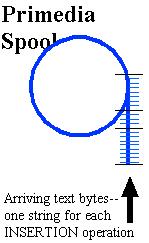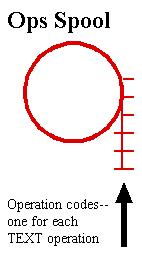osmicTwoSpools .html
99.01.25 ( d16
To Ted Nelson Home
Page
Return to main OSMIC page
The Two Spools of OSMIC
or,
Sometimes It's Easier to Keep
It All
THE MODEL OF STORAGE
In OSMIC, data is logically saved in the server as two
cumulative spools-- that is, Append-and-Read-Only files.


Arriving data is appended to the Primedia file.
Specifically, since we are presently dealing only with text, the text string
inserted by each insertion operation is appended to the primedia file.
A code for each edit operation is appended to the OPS
file. The code is defined in such a way as to permit replaying the
operation; thus a code for an insertion operation refers to the specific
text string which has been appended to the primedia file.
We intend that later primedia spools can receive audio
samples, video frames, fax scanlines, and other countable data. Indeed,
the code for handling the elements of a primedia file should be identical,
though elements may be different in different primedia files.
Versioning-On-Demand
The server does not store versions. Nothing stores
versions. Versions themselves are not saved, but regenerated as needed
from these two files.
The server keeps the primedia and opcodes, and versions
are built as needed in the client. That's why the client is much
bigger than the server.
LOGIC OF A VERSION
A version is completely specified by its microversion
number. This fully specifies the ascending sequence of opcode numbers
which lead up to it.
By beginning with the null document and numerically following
the forking sequence of operations through the hypertime map that lead
up to this microversion number, the microversion is rebuilt. When
a version forks, the process takes that turn on the map, like a model train.
Thus to regenerate a particular microversion, all that
is needed is to perform the lexically successive operations from state
zero to that desired microversion. (By "lexically successive" I mean
in numerical order, except where an alphabetical branch occurs.)
(We omit here the slightly more complex logic of enacting
the transclusion operation.)
THE INCREDIBLY SIMPLE PROTOCOL
The protocol, designed by Ken'ichi Unnai, is designed
to minimze network traffic and especially to keep the server as stateless
as possible.
The server has three functions:
Function 1) Receive an opcode from a client (with
a string if it is an insertion op) and store it under the appropriate ascending
opcode number (supplied by the client).
Function 2) In response to an opcode number sent
by the client, return the opcode (and the string for that opcode, if it
is an insertion op).
Function 3) In response to a request for a version,
send the entire series of opcode numbers, in sequence, required to regenerate
that version. Then, upon receiving each opcode from the client again,
perform function 2, sending out the corresponding opcode.
The reason the client des not generate the sequence of
opcodes is that clients are expected to be dumb.
OSMIC is best seen in operation. We suggest
you try out the prototype.
Return to main OSMIC page
,